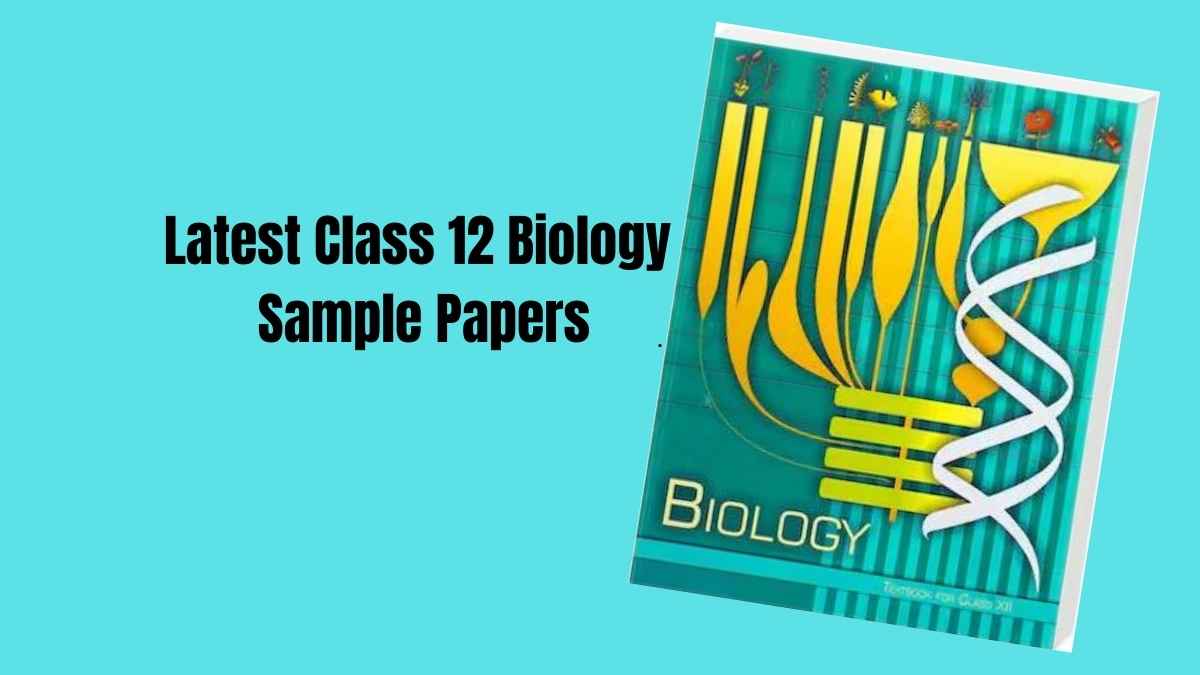Table of Contents
The CBSE Class 12th Biology Sample Paper 2024-25 with solutions has been released by the Central Board of Secondary Education (CBSE) at its official website. All the students who are aspiring to appear in the CBSE Class 12th Biology Final Exams 2024-25 to be held on March 25, 2025 can now download the subject-wise sample papers from https://cbseacademic.nic.in/ along with the marking scheme.
While practicing for the final exams students will have better insights and opportunities to complete their preparations with the use of the CBSE 12th Biology Sample Papers 2025. The direct links to download the sample papers have been added below in the article.
CBSE Class 12 Biology Sample Paper 2024-25
For all the students who are currently studying in class 12 (Physics, Chemistry, and Biology) and are preparing to appear in the Board Examination, the CBSE Class 12 Sample Paper 2024-25 is now live on the official website. The sample papers have been designed and prepared in a manner to replicate the final exam paper so that students can easily prepare their best and can also analyze their performance in the sample paper by using the marking scheme containing the answers to all the questions.
The CBSE Class 12 Biology Sample Paper 2024-25 comprises all the important topics including Biological Classification, Plant Kingdom, Morphology of Flowering Plants, Structural Organisation in Animals, Cell Cycle and Cell Division, Breathing and Exchange of Gases, Excretory Products and their Elimination, etc.
Class 12 Biology Sample Paper 2024-25 Download PDF with Answers
The CBSE Class 12 Biology Sample Paper for 2024-25 is now available on the official website. It helps medical stream students prepare for exams by showing the question pattern and important topics. The sample paper also comes with solutions for easy learning. Students can download the paper and marking scheme in PDF format using the given links. Practicing with the sample paper and following the marking guidelines will improve preparation and boost confidence for the exam.
| CBSE Class 12 Biology Sample Paper 2024-25 | ||
| Subject | Sample Question Paper (SQP) | Marking Scheme (MS) |
| Biology | Click Here | Click Here |
CBSE Class 12 Biology Exam Pattern 2025
The CBSE Class 12 Biology Exam 2025 is divided into five sections, covering different types of questions. These include multiple-choice questions (MCQs), short-answer questions, long-answer questions, and more. The exam aims to test the students’ understanding of the subject through a mix of objective and descriptive questions. Each section is designed to assess different skills like knowledge, application, and analysis. Students should carefully go through the detailed exam pattern, as shown in the table below, to prepare effectively and perform well in the exam.
| CBSE Class 12 Biology Exam Pattern 2025 |
|||
| Sections | Category | Marks | Number of Questions |
| Section A | Multiple Choice Questions (MCQs) | 1 mark each | 16 |
| Section B | Very Short Answers (VSA) | 2 marks each | 5 |
| Section C | Short Answers (SA) | 3 marks each | 7 |
| Section D | Long Answers (LA) | 5 marks each | 2 |
| Section E | Source-based/ Case-based | 4 marks each | 3 |
Previous Year’s Biology Sample Paper Class 12 with Solutions
Before their exams, students should check their preparation by solving previous years’ question papers. The Class 12 Biology Sample Paper with Solutions helps students understand their weak areas and improve their strong points. Practicing these papers will boost confidence and improve performance. By solving them, students can learn the exam pattern, important topics, and question types. It also helps in time management during the exam. These papers give a clear idea of how questions are framed and what to expect. Click the link to access these papers and practice well for better results in the exams.
| Previous Year’s Biology Sample Paper Class 12 with Solutions | |||
| Year | Subject | Sample Question Paper (SQP) | Marking Scheme (MS) |
| 2023 | Biology | Click Here | Click Here |
| 2022 | Biology | Click Here | Click Here |
| 2021 | Biology (Term 1) | Click Here | Click Here |
| Biology (Term 2) | Click Here | Click Here | |
CBSE Class 12 Biology Sample Questions 2024-25
Section – A
Q1. Signals for parturition in human female originate from
A. Fully developed foetus only
B. Both placenta as well as fully developed foetus
C. Placenta only
D. Oxytocin released from maternal pituitary
Ans. B. Both placenta as well as fully developed foetus.
Q2. To produce 1600 seeds, the number of meiotic divisions required will be
A. 2400
B. 2000
C. 1600
D. 1800
Ans. B. 2000
Formation of one seed requires fertilsation between one pollen grain and one egg. To produce 1600 seeds, 1600 pollen grains and 1600 eggs will be required. Each microspore mother cell results in the formation of 4 pollen grains after one cycle of meiotic division. So, 400 meiotic divisions will result in the production of 1600 pollen grains. One megaspore mother cell after one cycle of meiotic division results in the formation of 1 egg; so, 1600 meiotic divisions will take place to form 1600 eggs. Thus, total number of meiotic divisions required for the formation of 1600 seeds will be 400 + 1600 =2000.
Q3. A sample of normal double-stranded DNA was found to have thymine content of 27%. What will be the expected proportion of guanine in this strand?
A. 23%
B. 32%
C. 36%
D. 73%
Ans. A. 23%
According to Chargaff’s rules, in DNA, A =T and G=C;
Thus, A +T+G+C =100
Given T = 27% so A=T =27%
Thus A+T = 27 +27 =54%
Thus, G+C =100 – 54 = 46%
Since G = C so G = 46/2 =23%
Q4. Suresh and Rajesh have defective hemoglobin due to genetic disorders. In Suresh, the problem is qualitative as he is having incorrectly functioning globin molecules while in Rajesh the problem is quantitative as he is having very few globin molecules. Identify the disorder they are suffering from.
| Suresh | Rajesh | |
| A | Thalassemia – Autosomal Dominant blood disorder | Sickle Cell Anaemia – Autosomal linked Recessive trait |
| B | Sickle Cell Anaemia – Autosomal linked Dominant trait | Thalassemia – Autosomal Recessive blood disorder |
| C | Sickle Cell Anaemia – Autosomal linked Recessive trait | Thalassemia – Autosomal Recessive blood disorder |
| D | Thalassemia – Autosomal Dominant blood disorder | Sickle Cell Anaemia – Autosomal linked Dominant trait |
Ans. C.
| Suresh | Rajesh |
| Sickle Cell Anaemia – Autosomal linked Recessive trait | Thalassemia – Autosomal Recessive blood disorder |
Q5. In E.coli, the lac operon gets switched on when lactose is
A. present in the medium and it binds to the repressor.
B. not present in the medium and the repressor binds to the operator.
C. not present in the medium and RNA polymerase binds to the
operator.
D. Active lactose present in the medium binds to RNA polymerase.
Ans. A. present in the medium and it binds to the repressor.
Importance of Solving CBSE Class 12 Biology Sample Paper 2025
- Better Understanding of Exam Pattern – Practicing the CBSE Class 12th Biology Sample Papers will helps you know the types of questions and marking scheme.
- Boosts Confidence – Makes you feel more prepared for the actual exam.
- Reduces Exam Stress – Practicing regularly makes the exam feel easier and less stressful.
- Identifies Weak Areas – Helps you focus on topics that need more revision.
- Enhances Answer Writing Skills – Teaches you how to present answers effectively.


 Class 12 Informatics Practices CBSE Samp...
Class 12 Informatics Practices CBSE Samp...
 CBSE Class 12 Computer Science Sample Pa...
CBSE Class 12 Computer Science Sample Pa...
 CBSE Class 12 Accountancy Sample Paper 2...
CBSE Class 12 Accountancy Sample Paper 2...









